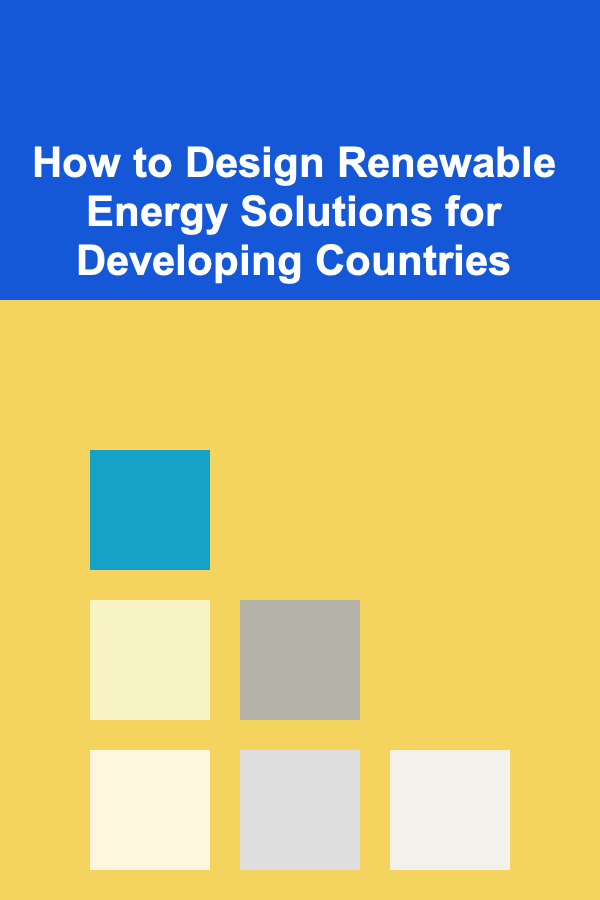
How to Design Renewable Energy Solutions for Developing Countries
ebook include PDF & Audio bundle (Micro Guide)
$12.99$8.99
Limited Time Offer! Order within the next:

Renewable energy has emerged as a critical component in addressing the dual challenge of providing electricity to underserved populations while simultaneously combating climate change. For developing countries, the shift toward renewable energy is not just a matter of environmental responsibility but an economic necessity and an opportunity to leapfrog traditional energy systems. This article delves into how to design effective renewable energy solutions for developing countries, emphasizing the unique challenges, opportunities, and strategic considerations that must be taken into account.
The Energy Crisis in Developing Countries
Many developing countries face significant energy access challenges. According to the International Energy Agency (IEA), nearly 800 million people around the world still lack access to electricity, and most of these are in sub-Saharan Africa and South Asia. The lack of reliable electricity exacerbates issues such as poverty, inequality, and limited access to education and healthcare. Traditional energy sources, such as coal, oil, and natural gas, are often either unavailable or unsustainable in these regions.
Renewable energy offers a promising solution, providing cleaner, more affordable alternatives that can be harnessed locally, reducing dependency on imported fuels and mitigating the environmental impact of fossil fuel consumption. Solar, wind, hydropower, and biomass are among the most common renewable energy sources that could significantly enhance energy access in these countries.
Challenges in Designing Renewable Energy Solutions
1. Infrastructure Deficits
One of the most significant barriers to renewable energy adoption in developing countries is the lack of infrastructure. Many regions suffer from inadequate grid systems, which are either too old, poorly maintained, or non-existent. This can make it difficult to deploy large-scale renewable energy projects that require a stable and reliable transmission and distribution system.
Moreover, many rural and remote areas are disconnected from the grid entirely. In such cases, off-grid solutions such as solar home systems (SHS), small-scale wind turbines, and mini-grids present viable alternatives, but they also require significant upfront investment and technical expertise to implement.
2. Financial Constraints
Developing countries often have limited financial resources to invest in renewable energy infrastructure. Initial capital for renewable energy projects is typically high, which can make them inaccessible without international aid, loans, or private investment. This financial challenge is compounded by the higher cost of financing in many developing countries due to poor credit ratings and high perceived risks.
In addition to the costs of installation, ongoing maintenance and operational costs can be prohibitive. The lack of local financial institutions equipped to handle renewable energy financing further complicates the situation.
3. Technological Barriers
While renewable energy technologies are increasingly affordable, many developing countries face technological barriers that hinder their adoption. These countries may lack the technical expertise to design, install, and maintain renewable energy systems. Training local technicians and engineers is essential to ensure that renewable energy projects are successful in the long term.
Furthermore, the integration of renewable energy into existing energy systems can be technically complex. Developing countries often need to enhance the reliability of their energy systems to accommodate the variable nature of renewable resources, particularly solar and wind energy.
4. Policy and Regulatory Challenges
Many developing countries lack comprehensive energy policies or regulatory frameworks that encourage the adoption of renewable energy. Without clear policies and regulations, renewable energy projects may face bureaucratic hurdles, making it difficult to implement projects efficiently. Additionally, some countries have entrenched fossil fuel interests that resist the shift to renewables due to economic or political reasons.
A robust policy framework that supports renewable energy investment, including subsidies, tax incentives, and renewable energy targets, is crucial to creating an enabling environment for renewable energy solutions.
Opportunities for Renewable Energy in Developing Countries
Despite these challenges, the potential for renewable energy in developing countries is vast. Many regions are rich in renewable resources such as solar energy, wind, and biomass, which can be harnessed to meet local energy needs. In addition to environmental benefits, renewable energy can drive economic development by creating jobs, improving health outcomes, and promoting energy security.
1. Solar Energy: The Power of the Sun
Solar energy is one of the most promising renewable energy sources for developing countries, especially those located near the equator, where sunlight is abundant year-round. Solar power is highly versatile and can be deployed in a variety of ways, from small-scale solar home systems to large solar farms.
In rural areas where grid connection is impractical or too expensive, off-grid solar systems can provide a decentralized solution for households and small businesses. Solar power is also an attractive solution for agricultural applications, such as irrigation, where it can replace costly diesel-powered pumps.
Solar microgrids have the potential to bring electricity to entire villages or communities, providing a sustainable and scalable energy solution without the need for extensive transmission infrastructure.
2. Wind Energy: Harnessing the Power of Wind
Wind energy has vast potential in many developing countries, particularly those with coastal regions or large open spaces. Wind turbines are well-suited for locations with consistent wind patterns, and small-scale turbines can be used to power villages, farms, or individual homes.
Like solar energy, wind energy can be deployed in both grid-connected and off-grid configurations. For example, wind-powered mini-grids can serve remote areas, providing a cost-effective way to generate electricity without relying on centralized power plants.
While wind energy may face initial cost barriers, its low operational costs and long lifespan make it a sustainable solution for energy access in the long term.
3. Hydropower: Leveraging Water Resources
Hydropower has long been a staple of renewable energy generation, especially in regions with abundant water resources such as rivers and waterfalls. Small-scale hydropower systems, often called micro-hydro, are a feasible option for providing electricity to rural areas in developing countries. These systems have the advantage of being able to generate consistent power with minimal maintenance.
The challenge with hydropower is that large-scale dams can have negative environmental impacts, including disruption of local ecosystems and displacement of communities. Small-scale hydropower systems, however, can mitigate these issues while providing reliable, renewable energy to off-grid communities.
4. Biomass: A Sustainable Energy Source from Waste
Biomass energy is derived from organic materials such as agricultural waste, wood, and animal dung. In many developing countries, agricultural residues and other waste products are readily available and can be used to generate electricity or heat. Biomass systems can be particularly useful in rural areas where other energy sources are scarce.
Biogas, a form of biomass energy, can be used for cooking and lighting, reducing reliance on traditional fuels such as wood and charcoal, which contribute to deforestation and indoor air pollution. The development of biomass energy systems can also create new economic opportunities in rural areas, where waste products are converted into valuable energy resources.
Designing Renewable Energy Solutions for Developing Countries
The design of renewable energy solutions for developing countries requires a holistic, context-specific approach that takes into account local resources, technical capabilities, economic constraints, and cultural factors. Below are some key considerations for designing successful renewable energy projects:
1. Assessing Local Resources and Needs
The first step in designing renewable energy solutions is to assess the local energy needs and available resources. Each community is unique, and solutions should be tailored to the specific context. For example, a solar-powered system may be ideal for a remote village with abundant sunshine, while a micro-hydro system may be more appropriate for a community located near a river.
A thorough assessment should include an analysis of the local energy demand, the availability of renewable resources, the technical feasibility of various solutions, and the potential for integrating renewable energy into existing infrastructure.
2. Engaging Local Communities
Community involvement is critical to the success of renewable energy projects. In many developing countries, communities may be unfamiliar with renewable energy technologies, or they may have cultural preferences that influence their energy choices. Engaging with local stakeholders early in the planning process ensures that projects are culturally appropriate and that there is local buy-in.
Community-based approaches, such as the formation of local energy cooperatives or the involvement of women in energy decision-making, can help ensure that renewable energy projects are sustainable and equitable.
3. Financing and Scaling Solutions
Given the financial constraints faced by many developing countries, finding appropriate financing mechanisms is essential. Governments, international organizations, and private investors must work together to provide the necessary capital for renewable energy projects.
Innovative financing models, such as pay-as-you-go solar systems, where consumers pay for electricity on a monthly basis, can help make renewable energy affordable for low-income households. Microfinance institutions can also play a critical role in providing financing for small-scale renewable energy projects.
Scaling renewable energy solutions is another key consideration. Once pilot projects have been successful, it is important to plan for scaling up to meet broader energy needs. This may involve extending the grid, increasing the number of mini-grids, or expanding access to off-grid systems.
4. Building Local Capacity
To ensure the long-term success of renewable energy projects, building local technical and managerial capacity is crucial. This includes training technicians, engineers, and entrepreneurs to design, install, and maintain renewable energy systems. Developing a skilled workforce will reduce dependency on foreign experts and ensure that projects can be sustained locally.
Moreover, local entrepreneurs can be encouraged to start businesses related to renewable energy, creating jobs and contributing to the local economy.
Conclusion
Designing renewable energy solutions for developing countries is a complex but highly rewarding endeavor. The transition to renewable energy can help address critical challenges such as energy access, environmental degradation, and economic development. By leveraging local resources, engaging communities, and fostering innovation in financing, technology, and policy, developing countries can unlock the full potential of renewable energy to create a more sustainable and prosperous future. While the road ahead is fraught with challenges, the opportunities that renewable energy offers make it an essential part of the development strategy for the future.
Reading More From Our Other Websites
- [Home Budget Decorating 101] How to Use Houseplants to Decorate Your Home Affordably
- [Polymer Clay Modeling Tip 101] Beginner's Guide: Essential Polymer Clay Hacks Every Crafter Should Try
- [Organization Tip 101] How to Implement a Paperless Office System
- [Personal Care Tips 101] How to Care for Your Skin with a Simple Routine
- [Paragliding Tip 101] Helmet Head-to-Head: Reviewing the Most Reliable Protective Gear for Pilots
- [Organization Tip 101] How to Keep Important Documents Organized as a Family
- [Home Rental Property 101] How to Set Competitive Rent Prices for Your Property
- [Home Lighting 101] How to Transform Your Backyard into a Paradise: Pool Lighting Installation & Design
- [Home Renovating 101] How to Perform DIY Plumbing Repairs for Common Issues
- [Personal Finance Management 101] How to Build Multiple Income Streams to Improve Financial Stability

How to Stage a Home with a Small Budget and Big Impact
Read More
The Environmental Engineer's Guide to Sustainable Solutions
Read More
How To Understand Bird Migration Patterns
Read More10 Tips for Staying Motivated While Tracking Your Net Worth
Read More
10 Tips for Meal Planning with Picky Eaters
Read More
10 Tips for Analyzing Your Poker Hands
Read MoreOther Products

How to Stage a Home with a Small Budget and Big Impact
Read More
The Environmental Engineer's Guide to Sustainable Solutions
Read More
How To Understand Bird Migration Patterns
Read More10 Tips for Staying Motivated While Tracking Your Net Worth
Read More
10 Tips for Meal Planning with Picky Eaters
Read More